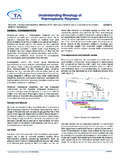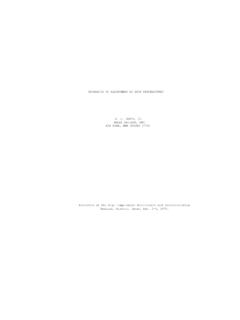Transcription of Characterization and Modeling of the Viscoelastic …
1 J. Aerosp. Technol. Manag., S o Jos dos Campos, , No 2, , , 2015 ABSTRACT: The goal of this study is twofold. The first one is to assess the applicability of approaches based on dynamic-mechanical analysis to investigate the Viscoelastic properties of a self-adhesive synthetic rubber. The second goal is to identify the parameters of a Viscoelastic model which accurately represents the frequency-dependent mechanical properties. For that purpose, the time-temperature superposition principle is successfully applied to build the master curves of the material up to 1 MHz. The thickness of the samples and the thermal expansion effects are found to have a negligible influence on the mechanical properties measured by dynamic-mechanical analysis.
2 The parameters of a generalized Maxwell model and a fractional derivative model are identified from the obtained master curves and lead to an accurate representation of the frequency-dependent mechanical properties of the : Dynamic mechanical analysis, Viscoelastic material, Generalized Maxwell model, Fractional derivative model. Characterization and Modeling of the Viscoelastic Behavior of a Self-Adhesive Rubber Using Dynamic Mechanical Analysis TestsLucie Rouleau1, Rog rio Pirk1,2, Bert Pluymers1, Wim Desmet1 INTRODUCTIONS tructural vibration reduction is a fundamental concern in several industries to avoid failure due to mechanical fatigue, to comply with increasingly stringent Noise, Vibration and Harshness (NVH) standards, or to ensure optimal operating conditions for on-board electronics.
3 There are several methods that may be used in order to control vibrations (Nakra, 1998), which can be divided in two categories: active and passive damping treatments. The former rely on the effect of active mechanisms, using for example piezoelectric actuators, while the latter takes advantage of the inherent energy dissipation effects of systems, using for example Viscoelastic materials (VEM). Passive damping treatments based on VEM have been widely used in a variety of industrial applications and especially in aircraft and automotive systems (Rao, 2003). Since their molecular structure allows the internal dissipation of part of the vibration energy (Ferry, 1980), VEM are usually applied on the surface of vibrating structures, as a constrained or unconstrained layer of material. Some add-on passive damping treatments are available commercially in the form of self-adhesive constrained layers, which offer the advantage of introducing damping with a minimum mass addition, while also being easily applied to structures with complex Characterization and Modeling of VEM mechanical properties are essential in the design and analysis of damped structures, to provide solutions with adequate damping properties.
4 However, the VEM material properties depend on many factors, doi: Universiteit Leuven Department of Mechanical Engineering Heverlee Belgium. de Ci ncia e Tecnologia Aeroespacial Instituto de Aeron utica e Espa o S o Jos dos Campos/SP for correspondence: Lucie Rouleau | Cnam Paris Structural Mechanics and Coupled Systems Laboratory | 2 rue Cont , 75003 | Paris France Email: 02/25/2015 | Accepted: 04/21/2015J. Aerosp. Technol. Manag., S o Jos dos Campos, , No 2, , , 2015201 Characterization and Modeling of the Viscoelastic Behavior of a Self-Adhesive Rubber Using Dynamic Mechanical Analysis Testssuch as temperature, excitation frequency, amplitude, pre-stress or relative humidity (Sj berg, 2002; Kergourlay, 2004). Temperature and frequency being the most relevant factors, it is indispensable to determine the material properties over the range of operational temperatures and frequencies.
5 Various existing techniques are available in the literature to characterize VEM as a function of temperature and frequency and are reviewed, among others, in Lakes (2004). Among them, dynamical mechanical analysis (DMA) is one of the most common and standard methods used to measure the dynamic properties of VEM (ASTM D4065-12; Menard, 2008). In this method, the response of VEM samples to a sinusoidal excitation at different frequencies and temperatures is measured. The dynamic properties over a wide frequency range are then extrapolated by means of the time-temperature superposition principle (TTSP). This method has been successfully applied to the Characterization of many polymers (Ferry, 1980; Emri, 2005; Dealy and Plazek, 2009). However, for some materials such as polymeric blends (Van Gurp and Palmen, 1998) or polymers with long chain branching (Hatzikiriakos, 2000), the TTSP may not be applicable anymore.
6 Moreover, in the case of adhesive polymers, the nonlinearity of the adhesive behavior may have an influence on the mechanical properties measured by DMA, as evidenced in Garc a-Barruetabe a et al. (2011). These observations motivate this study, of which the first goal is to assess the applicability of the DMA-based approach to investigate the Viscoelastic properties of a self-adhesive synthetic rubber. In particular, since self-adhesive materials (also called pressure-sensitive adhesives) are a type of polymer blends (Creton, 2003), both the applicability of the TTSP and the nonlinearity of the adhesive behavior should be the frequency-dependent properties of the VEM are determined, one needs to model viscoelasticity in order to obtain accurate results using finite element models and thus assess the performance of the passive damping treatment.
7 Several models exist in the literature to describe the Viscoelastic behavior of VEM (Bert, 1973; Vasques et al., 2010). The capacity of a Viscoelastic model to represent the frequency-dependent mechanical properties depends on the material. For instance, a fractional derivative model may lead to a good fit of the Viscoelastic properties of some polymers (Pritz, 2003), but a poor one for others (Corn et al., 2009). The second goal is then to identify the parameters of a Viscoelastic model which accurately represents the frequency-dependent mechanical properties. In this study, two Viscoelastic models are investigated: the generalized Maxwell model and the fractional derivative model. THEORY OF LINEAR VISCOELASTICITYC onsidering an isotropic Viscoelastic material under small isothermal and small deformation conditions, the theory of linear viscoelasticity assumes the existence of a constitutive relation between stress and strain histories, which for a one-dimensional system is given by a convolution integral (Christensen, 1982):where (t) and (t): respectively, the stress and strain at a given time t; E (t): stress relaxation modulus.
8 A convenient way of representing the Viscoelastic behavior in the frequency domain is through the complex modulus approximation. Let us assume a stationary harmonic strain (t):and a stationary harmonic stress (t):where i : imaginary unit, defined by its property i2 = 1; 0 and 0: respectively, the stress and strain amplitudes; : excitation frequency; : phase delay between the stress and strain. The constitutive equation linking stress and strain in the frequency domain is given by:where the complex modulus E*( ) can be written as:where E ( ): storage modulus; E ( ): loss factor. The loss factor ( ) = E ( )/E ( ) is a measure of the energy dissipated in the material, expressed in terms of recoverable energy. The storage and loss moduli, as well as the loss factor, are related to the phase and amplitude differences between stress and strain:(1)(2)(5)(3)(4)t- (t) = E(t - ) (t)d 0i t (t) = e0i( t + ) ( ) = E*( ) ( )E*( ) = E ( ) + iE ( ) = E ( )[1 + i ( )] (t) = eJ.
9 Aerosp. Technol. Manag., S o Jos dos Campos, , No 2, , , 2015202 Rouleau, L., Pirk, R., Pluymers, B. and Desmet, , by measuring the time response of a sample of material to an imposed strain, DMA testing allows the measurement of the complex modulus defined in Eq. 5. However, the measurements which can be performed on most commercial DMA equipment are limited to the low-frequency domain (typically up to a few hundred Hz). In order to characterize the material on a broader frequency range, the TTSP is applied (Ferry, 1980). This principle relates the material response at a given time t (or frequency ) and at a given temperature T to that at other conditions (denoted by subscript r):frequency range on which the material properties are known. However, the TTSP holds only for materials which are called thermo-rheologically simple (Dealy and Plazek, 2009).
10 The Black diagram (Van Gurp and Palmen 1998) (plot of the phase angle versus the amplitude of the complex modulus) and the Cole-Cole diagram (Han and Kim, 1993) (plot of the storage modulus versus the loss modulus) are two indicators commonly used to assess the applicability of the MECHANICAL ANALYSIS EXPERIMENTSThe material studied is a self-adhesive synthetic rubber (SR) from an automotive TIER supplier. Measurements of where aT(T, Tr ) and bT(T, Tr): coefficients which indicate the amount of horizontal and vertical shifting (respectively) to be applied to isotherms of storage and loss moduli measured at a temperature T in order to estimate the material properties at a reference temperature Tr (see Fig. 1). The horizontal shift factors aT(T, Tr ) describe the temperature dependence of the relaxation time and usually follow the empirical Williams-Landel-Ferry (WLF) equation (Williams et al.)
















